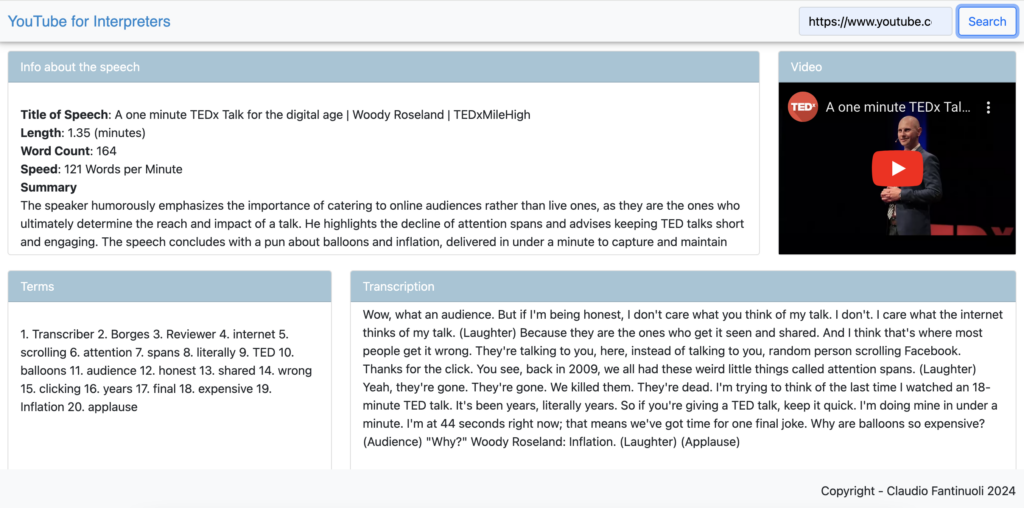Interpreting training relies on teachers providing students with suitable speeches to practice. Many times, trainers offer background information for preparation and transcripts of the originals for checking the quality of the rendition. The importance of training materials is demonstrated by the so-called repositories of speech curated by international organizations such as the European Union, with its well-known speech repository, or the newly launched United Nations database called the speech bank. Their usefulness is undoubted: they compile many speeches in one place, curate the level of the speech (which is still a very general categorization but nonetheless useful), etc. However, they have major shortcomings, particularly in that they do not provide enough information to prepare and evaluate the rendition. This is crucial not only in ordinary face-to-face classes but also, and foremost, in the context of self-learning.
I am a firm believer in the necessity of helping students free themselves from dependency on trainers and training institutions, and I think information technology and AI can offer great help here (see this post about other forms of supporting self-learning for interpreting students). I am also a believer in helping trainers gain more autonomy in preparing material for classes.
Speeches are everywhere on YouTube (see this collection of English speeches)! For this reason, I put together a simple experimental app mimicking what I was doing to prepare my lessons to integrate YouTube videos into students’ practice and teachers’ classes. This app, designed with interpreters in mind, allows users to leverage the wealth of online video content for educational and training purposes. It is a weekend project, so don’t expect miracles. Here’s a closer look at how this app can help with interpreting practice.
Key Features of the App
- YouTube Integration:
The app enables you to incorporate any YouTube video into your interpreting practice. Simply enter the URL of the video, and the app takes care of the rest. - Content Briefs:
Upon entering the video URL, the app generates a brief description of the video’s content. This summary provides a quick overview, helping you decide if the video is suitable for your practice session or class. - Video Metrics:
The app offers detailed metrics of the video, including the length, and speaking speed. These metrics can help interpreters to gauge the complexity and suitability of the content for their skill level and training objectives. Much more can be done here. - Terminology Extraction:
One of the standout features of this app is its ability to extract key terminology from the video. This feature is particularly useful for students to familiarize themselves with specialized vocabulary and jargon, enhancing their preparedness. - Full Transcription:
The app provides a full transcription of the video. This transcription can be used to practice interpreting in real-time (interpreting with text) or to review and assess the quality of the interpretations. Having a text version of the speech allows for more thorough analysis and reflection.

Practical Applications
- Preparation for Assignments:
The app can be used to prepare for actual interpreting assignments by practicing with videos that are similar in content and context. The brief descriptions and terminologies help in understanding the subject matter better. - Classroom Integration:
Teachers and trainers can use this app to bring real-world content into the classroom, making interpreting exercises more dynamic and relevant. The ability to generate transcriptions and metrics allows for a structured approach to teaching and assessment. - Self-Learning and Improvement:
For interpreters who are self-learning, this app provides a comprehensive tool to enhance their skills. The access to a wide range of content, along with the analytical features, supports continuous learning and self-assessment.
What do do in the future? Time allowing, it would be nice to extend language support (easy task), to improve the metrics (a nice MA work for a student could be correlating textual metrics to levels of interpreting), and make error handling more robust (not all YouTube links work).
If you want to try out the free app, visit my-interpreter.com.